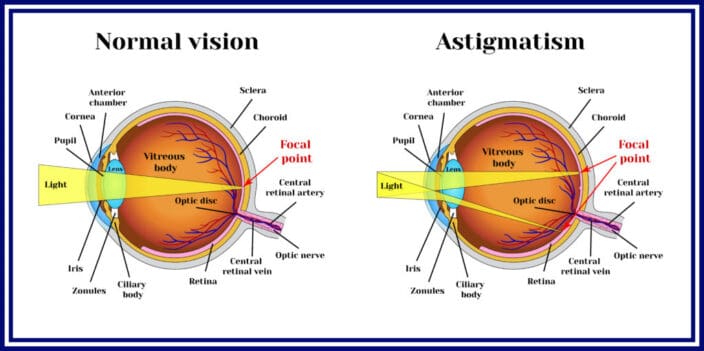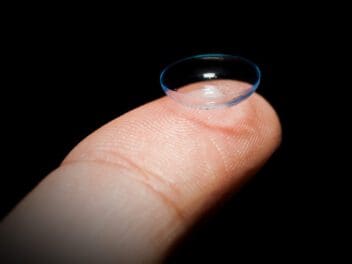Further Reading
Contacts for Astigmatism: Lens Options & How to Choose
Home / Understanding Contacts /
Last Updated:
In the United States, approximately one in three people has astigmatism. This is a type of refractive error that people use corrective lenses to address.
There are contact lenses for astigmatism. Certain contact lenses work better for this condition, helping to improve vision to the maximum degree.
Table of Contents
Before looking at the types of contact lenses you might wear for astigmatism, it is beneficial to learn more about how these lenses work. This information can help you in choosing the lenses that best meet your vision needs.
The next step is looking at the contact lens options for astigmatism. There are different types for you to choose from, depending on your vision and personal preferences.
What Is Astigmatism?

When this condition is present, light does not focus evenly on the retina. When light enters the eye when astigmatism is present, the image looks stretched out and blurry. This is because astigmatism causes the cornea to have more of a football shape than a baseball shape. Some areas of the cornea are more rounded or steeper than others, making it less symmetrical.
Adults and children can develop astigmatism. When the condition is slight, it is possible to not experience obvious symptoms and vision changes. In some cases, people do not know they have astigmatism until it is noticed at an eye examination.
You deserve clear vision. We can help.
With 135+ locations and over 2.5 million procedures performed, our board-certified eye surgeons deliver results you can trust. Your journey to better vision starts here.
When symptoms occur, they may include:
- Distorted or blurry vision.
- Headaches
- Squinting to try and see more clearly.
- Discomfort or eyestrain.
- Trouble with night vision.
There are three primary types of this refractive error.
- Hyperopic astigmatism means that there is farsightedness in one or both of the principal meridians.
- Myopic astigmatism means that there is nearsightedness in one or both of the principal meridians.
- Mixed astigmatism means that there is farsightedness in one principal meridian and nearsightedness in the other.
It is possible to have astigmatism along with another refractive error, such as farsightedness and nearsightedness.
Refractive surgery and corrective lenses are the treatment options for astigmatism. People who prefer to avoid surgery but don’t want to wear eyeglasses can opt for contact lenses.
How Contact Lenses Work

A contact lens is a small lens that sits directly on the eye. Contact lenses are essentially tiny prescription lenses that float on the corneal surface’s tear film layer. They work to correct refractive errors.
They function like traditional eyeglasses. However, since they sit on the eye, they also move with the eye naturally.
To put it simply, contacts work by altering light ray direction to warrant proper focus onto the retina. This ensures clearer vision.
Prescription Measurements
Diopters are the units of measurement that describe the power of a contact lens. When someone with astigmatism gets a prescription for contact lenses, they will see numbers.
If someone has 0 diopters, this means that there is no astigmatism in their eye. Once someone has 1.5 diopters or higher, they typically require corrective lenses to have clear vision.
Corrective lens prescriptions will show three numbers, including spherical, axis, and cylinder. If someone has astigmatism only, they just have to focus on the axis and cylinder numbers.
Cylinder describes the degree of astigmatism. This represents how irregular or flat their corneal shape is.
Axis represents where astigmatism is located on their cornea. The numbers range from 0 to 180.
If someone has another refractive error along with astigmatism, they will also need to look at the spherical figure. Farsightedness is represented by a plus sign (+) and nearsightedness is represented by a minus sign (-). As the prescription strength increases, the number that accompanies the plus or minus sign increases.
You deserve clear vision. We can help.
With 135+ locations and over 2.5 million procedures performed, our board-certified eye surgeons deliver results you can trust. Your journey to better vision starts here.
Exploring Contact Lenses for Astigmatism

There are different contact lens types that people can evaluate to determine which will be the best for vision correction. The three most common contact lenses for astigmatism include toric, gas permeable, and hybrid lenses.
- Toric contact lenses: Toric lenses are soft. In the different meridians, they have different powers. They allow the lens to rotate due to their design. This ensures clearer vision since the lens is able to align with the appropriate meridians. Compared to a regular soft lens, it can require more expertise to ensure a proper fit with toric lenses. People may also need to experiment with different designs and brands before they find the one that offers the best fit.
- Gas permeable (GP) contact lenses: This type of lens does not need a toric design to correct astigmatism in most cases. This is due to the rigidity of the lenses that allow GP lenses to retain their spherical shape when on their eyes. This type of lens has a uniform front surface that essentially “replaces” the person’s misshapen cornea. This allows for light to hit the retina in a way that ensures clearer vision. There are GP lenses that have a toric design. However, unless someone has an unusual astigmatism type or a high level of astigmatism, GP lenses with a toric design are not usually necessary.
- Hybrid contact lenses: Hybrid lenses have a silicone hydrogel or a hydrogel fitting zone that surrounds a rigid gas permeable lens. They essentially provide the benefits of both gas permeable and toric lenses. Like a toric lens, they are soft and comfortable. Like a GP lens, they provide sharp vision.
Hybrid lenses are approximately the same size as a toric lens, but compared to GP lenses, the edges are thinner. This reduces the risk of lens dislodgement when someone is playing sports or engaging in similar activities.
It is important that these lenses are fitted properly. Once someone gets their hybrid lenses, they do not have to be replaced as often as soft lenses. This can be convenient and reduce replacement costs.
Top Brands of Astigmatism Lenses
Toric
- Acuvue Oasys for Astigmatism 6 PK Contact Lenses – $34.99
- Biofinity Toric 6 PK Contact Lenses – $50.99
- PureVision 2 For Astigmatism Contact Lenses – $53.99
Gas permeable (GP)
- Boston XO2 RGP contacts by Bausch and Lomb – $100
- Fluoroperm 30 RGP contact lenses by Paragon Vision Sciences – $180
- Single Vision/Spherical RGP – $75.00
A Personalized Choice
There are several options for people with astigmatism. Talk to your doctor about which option will work best for your eyes and your lifestyle.
You deserve clear vision. We can help.
With 135+ locations and over 2.5 million procedures performed, our board-certified eye surgeons deliver results you can trust. Your journey to better vision starts here.
References
- Eye Health Statistics. American Academy of Ophthalmology.
- Facts About Astigmatism. National Eye Institute.
- Astigmatism. Mayo Clinic.
- Astigmatism. All About Vision.
- How Do Contacts Work? All About Vision.
- What Do Astigmatism Measurements Mean? American Academy of Ophthalmology.
- Contact Lenses for Astigmatism: Toric, GP, and Hybrid Lenses. All About Vision.
- What is astigmatism? (June 26, 2019). National Eye Institute.
- Optimizing outcomes with toric intraocular lenses. (December 2017). Indian Journal of Ophthalmology.
This content is for informational purposes only. It may have been reviewed by a licensed physician, but is not intended to serve as a substitute for professional medical advice. Always consult your healthcare provider with any health concerns. For more, read our Privacy Policy and Editorial Policy.